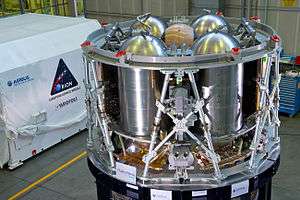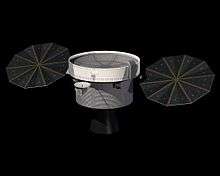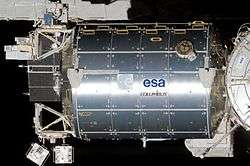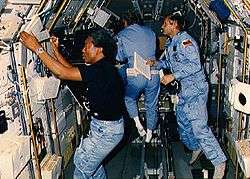Orion Service Module

The Orion Service Module is the service module component of the Orion spacecraft, serving as its primary power and propulsion component until it is discarded at the end of each mission. In January 2013, NASA announced that the European Space Agency (ESA) will construct the service module for Exploration Mission 1, replacing the previous design. Based on ESA's Automated Transfer Vehicle (ATV), the new design is also known as the European Service Module (ESM).
The service module supports the crew module from launch through separation prior to reentry. It provides in-space propulsion capability for orbital transfer, attitude control, and high altitude ascent aborts. It provides the water and oxygen needed for a habitable environment, generates and stores electrical power, and maintains the temperature of the vehicle's systems and components. This module can also transport unpressurized cargo and scientific payloads.
History
Old design

Roughly cylindrical in shape, the original American-designed Orion service module, would, like the crew module, have been constructed of Al-Li alloy (to keep weight down), and would have featured a pair of deployable circular solar panels, similar in design to the panels used on the Mars Phoenix lander. The panels, the first to be used on a U.S. manned spacecraft (except for a 10-year period, the Soviet/Russian Soyuz spacecraft has used them since the first mission in 1967), would allow NASA to eliminate the need to carry malfunction-prone fuel cells, and their associated hardware (mainly LH2 tanks) in the service module, resulting in a shorter, yet more maneuverable spacecraft. Successful initial testing of an Orion solar array design using full-scale "UltraFlex wing" hardware was reported in October, 2008.[1]
The Orion Main Engine (OME) was a 7500-pound thrust, pressure-fed, regeneratively cooled, storable bi-propellant rocket engine to be made by Aerojet. The OME was an increased performance version of the 6000-pound thrust rocket engine used by the Space Shuttle for its Orbital Maneuvering System (OMS). The SM Reaction Control System (RCS), the spacecraft's maneuvering thrusters (originally based on the Apollo "quad" system, but resembling that used on Gemini), would also be pressure-fed, and would use the same propellants. NASA believed the SM RCS would be able to act as a backup for a trans-Earth injection (TEI) burn in case the main SM engine fails.
A pair of LOX tanks (similar to those used in the Apollo SM) would provide, along with small tanks of nitrogen, the crew with breathing air at sea-level or "cruising altitude" pressure (14.7 or 10.2 psi), with a small "surge tank" providing necessary life support during reentry and touchdown. Lithium hydroxide (LiOH) cartridges would recycle the spacecraft's environmental system by "scrubbing" the carbon dioxide (CO2) exhaled by the astronauts from ship's air and adding fresh oxygen and nitrogen, which was then cycled back out into the system loop. Because of the switch from fuel cells to solar panels, the service module would have an onboard water tank to provide drinking water for the crew, and (when mixed with glycol), cooling water for the spacecraft's electronics. Unlike the practice during Apollo of dumping both water and urine overboard during the flight, the Orion would have an onboard recycling system, identical to that used on the International Space Station, to convert both waste water and urine into both drinking and cooling water.
The Service Module also mounted the spacecraft's waste heat management system (its radiators) and the aforementioned solar panels. These panels, along with backup batteries located in the Orion CM, would provide in-flight power to the ship's systems. The voltage, 28 volts DC, was similar to that used on the Apollo spacecraft during flight.
The Orion service module would be encapsulated by fiberglass shrouds jettisoned at the same time as the LES/Boost Protective Cover, which would take place roughly 2½ minutes after launch (30 seconds after the solid rocket first stage was jettisoned). Prior to the "Orion 606" redesign, the Orion SM resembled a squat, enlarged version of the Apollo Service Module. The "Orion 606" SM design retained the 5-meter width for the attachments of the Orion SM with the Orion CM, but utilized a Soyuz-like service module design to allow Lockheed Martin to make the vehicle lighter in weight and permitting the attachment of the circular solar panels at the module's midpoints, instead of at the base near the spacecraft/rocket adapter, which might have subjected the panels to damage.
The Orion service module (SM) was projected comprising a cylindrical shape, having a diameter of 5.03 m (16 ft 6 in) and an overall length (including thruster) of 4.78 m (15 ft 8 in). With solar panels extended, span was either 17.00 m (55.77 ft) or 55.00 ft (16.76 m). The projected empty mass was 3,700 kg (8,000 lb), fuel capacity was 8,300 kg (18,000 lb).[2][3]
ATV-based module

In May 2011 the European Space Agency (ESA) Director General announced a possible collaboration with NASA to work on a successor to ESA's Automated Transfer Vehicle (ATV).[4] ESA's provision of this successor could be counted towards its 8% share of the operating costs of the International Space Station (ISS); the ATV missions resupplying the station only covered this obligation up to 2017. On 21 June 2012, Astrium announced that it had been awarded two separate studies to evaluate possible future missions building on the technology and experience gained from its development of ATV and the Columbus laboratory. The first study looked into the construction of a service module which would be used in tandem with the Orion capsule.[5] The second examined the production of a versatile multi-purpose orbital vehicle. Each study was worth €6.5 million.[6]
In November 2012, ESA obtained the commitment of its member states for it to construct an ATV-derived service module for Orion, to fly on the maiden flight of the Space Launch System, thereby meeting ESA's budgetary obligation to NASA regarding the ISS for 2017–20.[7] No decision was made about supplying the module for later Orion flights.[8]

In January 2013, NASA announced its agreement, made the preceding December, that ESA would build the service module for Exploration Mission 1, then scheduled to take place in 2017. This service module was not required for Exploration Flight Test 1 in 2014, as this used a test service module supplied by Lockheed Martin.[9] On 17 November 2014 ESA signed a €390 million contract with Airbus Defence and Space for the development and construction of the ATV-based service module.[10]
The new design, sometimes referred to as the European Service Module (ESM),[11] is c. 16.5 feet (5.0 m) in diameter and c. 13 feet (4.0 m) in length, and made of aluminium-lithium alloy.[12]
The new design for the solar arrays, replacing ATK's circular UltraFlex design,[13] is by Airbus Defence and Space,[12] whose subsidiary, Airbus Defence and Space Netherlands (then known as Dutch Space), built the ATV's X-shaped array of four panels. The ATV's array generated 4.6 kilowatts. The upgraded version for the service module will generate about 11 kilowatts,[13] and will span about 62 ft (19 m) when extended.[12]
In September 2015, Thales Alenia Space signed a contract with Airbus Defence and Space to develop and produce thermomechanical systems for the service module, including structure and micrometeoroid protection, thermal control and consumable storage and distribution.[14]

Lockheed Martin is building the two adapters, connecting the service module to the crew module and to the upper stage of the Space Launch System, and also the three fairing panels that are jettisoned after protecting the service module during launch and ascent.[12]
The service module's main engine for Exploration Mission 1 will be a Space Shuttle Orbital Maneuvering System (OMS) engine left over from the Space Shuttle program,[11] in which it flew on 19 missions and carried out 89 burns.[12]
See also
References
- ↑ "NASA and ATK Successfully Deploy 18-Foot Diameter Solar Array for ST8 Program". ATK. 9 October 2008.
- ↑ "The Orion Service Module". NASA. 4 August 2008. Retrieved 2008-08-19.
- ↑ "Orion". Encyclopedia Astronautica. Retrieved 2013-05-11.
- ↑ "US and Europe plan new spaceship". BBC News. 5 May 2011. Archived from the original on 6 May 2011. Retrieved 2011-05-14.
- ↑ "ATV evolution studies look at exploration, debris removal". Spaceflight Now. 21 June 2012. Retrieved 2012-06-23.
- ↑ "Astrium awarded two ATV evolution studies from ESA". Astrium. 21 June 2012. Retrieved 2012-06-23.
- ↑ Bergin, Chris (November 21, 2012). "UK steps up, as ESA commit to ATV Service Module on NASA's Orion". NASASpaceFlight.com. NASA. Retrieved 2013-05-06.
- ↑ Clark, Stephen (November 21, 2012). "ESA member states fund Orion service module". Spaceflight Now. Retrieved 2013-05-06.
- ↑ NASA Signs Agreement for a European-Provided Orion Service Module
- ↑ "ESA Commissions Airbus Defence and Space as Prime Contractor for US Space Capsule Orion Service Module". spaceref business. 17 November 2014. Retrieved 18 November 2014.
- 1 2 Bergin, Chris (20 June 2015). "Plum Brook prepped for EM-1 Orion Service Module testing". NASASpaceFlight.com. Retrieved 28 July 2015.
- 1 2 3 4 5 Garcia, Mark (17 June 2015). "NASA Gears Up to Test Orion's Powerhouse". NASA. Retrieved 28 July 2015.
- 1 2 Leone, Dan (1 August 2013). "Ousted from First Orion Flight, Circular ATK Solar Arrays Still Set To Power Cygnus". Space News. Retrieved 28 July 2015.
- ↑ "Thales Alenia Space to supply thermomechanical systems for Orion ESM".
.jpg)

